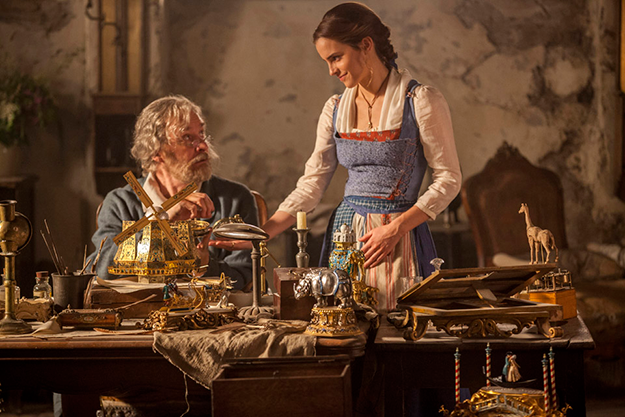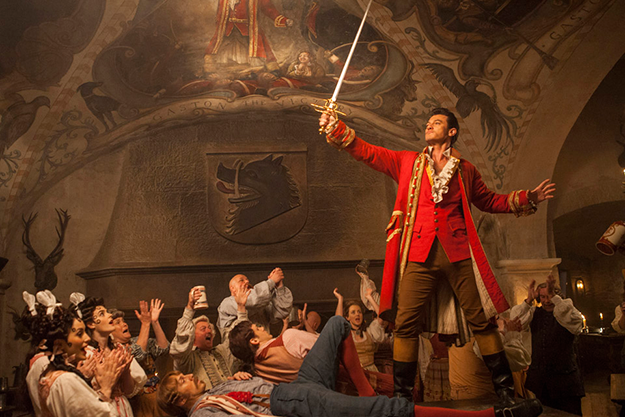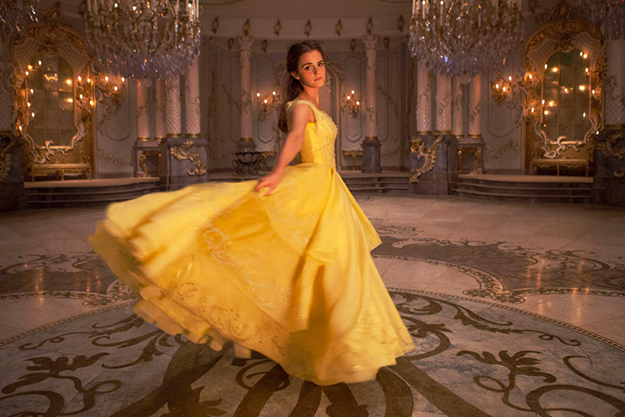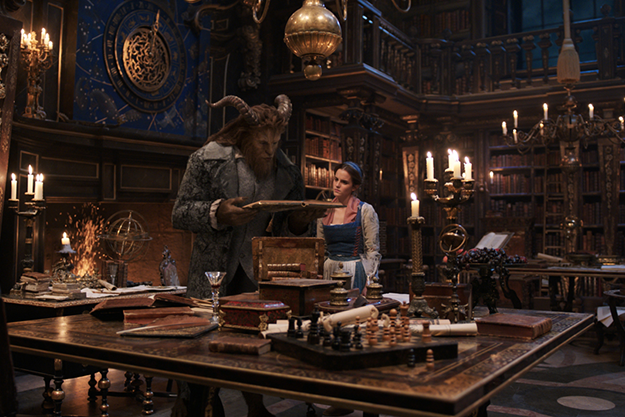Deep Focus: Beauty and the Beast

David Bowie once sang, “You can’t say no to the Beauty and the Beast.” He might have changed his tune if he’d lived to see the latest Disney extravaganza. Bill Condon’s live-action remake of Gary Trousdale and Kirk Wise’s Beauty and the Beast (1991), the high point of Disney’s animation renaissance, is as bloated, awkward, and aggressive as the cartoon feature is fleet and graceful.
Screenwriters Stephen Chbosky and Evan Spiliotopoulos have contributed revamps and additions that come off as heavy-handed editorial doodles. Belle (Emma Watson), the beautiful village bookworm, now invents a primitive washing machine to give herself more time to read, then scandalizes her neighbors with her advocacy of female education. I loved Watson in the Harry Potter films and in My Week with Marilyn and The Perks of Being a Wallflower (written and directed by Chbosky), but here she appears to have poured her passion into insuring the political correctness of her role. Pleasant and almost impossibly pretty, she occasionally gets off a mischievous delivery of a line or lyric or an instinctive gesture. She is funny when singing that she finds the Beast’s attractiveness “alarming,” and she is touching when she lifts her arms up shoulder-high to dance with him. But this Belle is more about Virtue than Wit—or Beauty.
Gaston, the lout who wants to marry her, is not just a champion hunter but also a thickheaded war hero. Not even Luke Evans, who gives the most energetic and ebullient performance, can navigate Gaston’s change from comic-dramatic brute to militaristic bully as laid out in this film’s prosaic scenes. (Under Gaston’s influence, the village people turn on a dime, or a sou; until the clumsy circus-slapstick climax, they resemble the mobs in Blazing Saddles and Young Frankenstein played semi-straight.) The cartoon moves swiftly and confidently from romantic comedy to romantic melodrama because it stylizes everything beautifully and consistently. The animated Gaston has the granite jaw and gleaming choppers of Wally Wood’s “Superduperman” in Mad Magazine #4. One of the wittiest things in the cartoon is how his otherworldly perfect teeth contrast with the fangs of Belle’s true love, the Beast. A wonderful humanoid buffalo in the cartoon, convincingly menacing when he paces on all fours, yet with craggy, eloquent facial planes and prominent eyes, the Beast is now a smoothed-out big-horned sheep. His horns are his only commanding features.

The best big-screen Beasts, including Jean Marais’s in Jean Cocteau’s great movie and several versions of King Kong, convey mesmerizing blends of humanity and animal ferocity. This film’s Beast (a low-energy Dan Stevens) may save Belle’s life when he fights off woman-eating wolves, but the designers and director smother his glorious hybrid character in generic amped-up growls and rich thick fur. When Belle finally sees him as a smooth-skinned, twinkling man, she asks him, in the middle of a dance, how he’d feel about growing a beard. The joke falls woefully flat, especially if we recall Greta Garbo’s reaction to the ending of Cocteau’s movie: “Give me back my beast!”
These filmmakers mistake sledgehammer strokes of backstory for emotional complexity and character development. We learn that this Beast’s corrupt widowed father twisted his son into a smarmy, decadent character when he was just a prince. On the other hand, Belle’s devoted, melancholy father, Maurice (Kevin Kline), now an artist and music-box maker, took Belle from Paris to a small provincial town to escape the plague that killed her mother. Kline underplays his small role brilliantly, and refreshingly. Otherwise, it’s tough to decide what’s worse: the film’s stabs at 21st-century profundity or its faux 18th-century visual style. The original contained a sophisticated architectural joke: the Beast’s castle was said to contain, underneath its intricate façade, “a minimalist rococo design”—of course, a contradiction in terms. This film suffers from a maximalist rococo design. It’s so overblown and ornate that it’s hard to focus on the crux of the tale: Belle’s recognition of the handsome spirit inside the Beast. The movie lacks the cartoon’s showbiz charge and inspiration and, more crucially, its soul.
Condon has done marvelous movie musicals before: he wrote the script for Chicago (2002) and wrote and directed Dreamgirls (2005). But here he fails to translate the deft stylization of classic cartoon figures into flesh-and-blood performances or expressive digital images. The computer-generated versions of Lumière the candelabra (Ewan McGregory), Cogsworth the clock (Ian McKellen), Mrs. Potts the teapot (Emma Thompson), and the other living objects in the Beast’s enchanted palace, neither mirror the personalities of the voice actors nor take on lives of their own. In the cartoon, it’s just the opposite: Jerry Orbach’s Lumiére, David Ogden Stiers’s Cogsworth, and Angela Lansbury’s Mrs. Potts remain prime musical-comedy creations.

Once again, the story begins with a handsome prince spurning a beggar woman’s request for shelter—and her gift of a single rose—because of her haggish appearance. Once again, she emerges as an enchantress who turns his staff into household objects and condemns him to beasthood until he proves himself able to love someone and be loved in return. (The deadline comes when the last petal drops from her magic rose.) But Condon turns this good witch into a would-be poignant character named Agathe (Hattie Morahan) and depicts her interrupting the hideously glammed-up prince and courtiers during a debased debutante ball. Instead of the original’s gorgeous stained-glass perfection we get a dull kindergartener’s vision of sinful luxury. (And it’s no masterstroke to thread Agathe in and out of the action, telegraphing each change to Belle and the Beast’s fortunes.)
In a double-whammy of ugliness, life is equally unpleasant back in Belle’s picturesque hamlet, where Belle warbles “Bonjour,” a combination small-town lament and wake-up-in-the-morning song, against a hyped-up chorus that registers as a grotesque tapestry of village life. Condon and company disastrously misjudge the effect of transforming brush-and-ink caricatures into fleshy costumed characters. Trousdale and Wise’s ingenious animation artists simultaneously exploited and mocked conventions. The three cartoon women who faint over Gaston while Belle spurns him are jovial parodies of dizzy blondes from movies and comic-strips past, and Trousdale and Wise lavish affection on their sexual giddiness. Here they’re dumb brunettes, powdered and rouged and wearing frightful wigs. Divorced from any pop-culture tradition, they’re unfunny figures of ridicule, like nearly everyone else in town except Belle and her dad.
Even in the cartoon, I thought the treatment of Belle was a tad too earnest. Instead of completely chiming in with Belle’s point of view, it would have been generous for Trousdale and Wise to suggest, as Victor Fleming did with Dorothy in The Wizard of Oz, how the heroine’s thirst for romance, adventure, and transcendence color her impression of the people around her. The live-action movie is far more devoted to heroine worship. It’s as if Condon and company think that fitting out a fairy tale for 2017 audiences is a matter of making every detail and conflict more extreme and more flattering to the protagonist. Now the town doesn’t have a kindly bookseller; Belle must borrow her reading material from the priest’s modest library. Belle’s attempt to teach a little girl how to read brings down the local headmaster’s wrath on her head.

Much might be forgiven if Condon had brought off the Howard Ashman–Alan Menken songs with élan. (Menken and Tim Rice have contributed a few new numbers.) But his conceptions are oppressively busy and devoid of poetry. There’s scarcely any dance as opposed to posing, stomping, or power-walking, so I was surprised to see a choreography credit (it goes to Anthony Van Laast, who recently did Mamma Mia!). In the cartoon, “Be My Guest “ is both the epitome and a parody of showstoppers. Here it’s just a failed Busby Berkeley number.
One of the major influences on “Belle” was the “Who Will Buy?” number from Carol Reed’s magnificent Oliver! (Film snobs have never given that great movie musical the respect it deserves.) In 1991, the animators smartly envisioned the village coming to life in depth and slid easily from Belle’s perspective to that of the townsfolk. Here Condon cuts on the most obvious beats between Belle and Gaston and his dullard sidekick LeFou (Josh Gad) or from Belle with book in hand to the scowling chauvinist headmaster and his troops. Evans and Gad bring panache to Gaston’s big number, but not even their muscle memory as theater performers can salvage the overly hearty staging. The animated LeFou is like a tubby version of the baby-macho posers in 1940s cartoons like Pinocchio. This film turns LeFou’s unrequited bromance with Gaston into a gay crush and running—or rather, stumbling—joke.
The advance raves called Condon’s work “old-fashioned.” If this clunky fantasia is what some reviewers consider traditional and craftsmanlike, they should take another look at Oliver!, where Reed’s mastery of rhythm, composition, and, most important, fable, is enough to make us weep: once for its own exhilarating achievement, and once in recognition that we might never see its like again. All Beauty and the Beast does is pick Oliver!’s pocket.
Michael Sragow is a contributing editor to Film Comment and writes its Deep Focus column. He is a member of the National Society of Film Critics and the Los Angeles Film Critics Association. He also curates “The Moviegoer” at the Library of America website.







